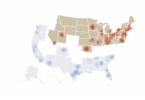2019 emerging market trends and how they compare to 2018
By Michael Chazin
Low residential mortgage rates currently make home purchases more affordable, driving demand, especially for starter homes and new construction. “The market is similar to what it was a year ago, with even less inventory available this year,” says Jeff Scislow, CRS, RE/MAX Results, Apple Valley, Minnesota. “Low inventory always tends to put upward pressure on home prices,” he says.
The residential real estate market in 2019 shares many of the same dynamics as last year’s market. “Last year we started to see corrections in February,” says Thomas J. Nelson, CRS, Big Block Realty, San Diego. “It was obvious by July, and that was evidenced by buyers slowing down.” Listings started to sit longer. “Houses that were move-in-ready sold quickly, but ones with deferred maintenance were more subject to price reductions,” he says.
This year the market has stabilized. “It is not all that different from a year ago,” Nelson says. Prices this spring were comparable to last October.
Affordability
The impact of lower rates makes housing more affordable. This past March, 30-year mortgage rates dropped below 4%, roughly 1.5 points lower than late 2018. “When rates drop this much, the payment is significantly less,” Scislow says. “That has improved affordability of houses, especially at the entry level.”
When an abundance of buyers meets a paucity of affordable homes, prices invariably increase. Scislow points to a recent listing of his that was affordably priced at $265,000. Seven buyers entered a bidding war and the price was driven up to $300,000. “Normally it would have gone up $10,000–$15,000 above asking price,” he says. “But $35,000 more—I’d say my seller hit the jackpot.”
As recently as last year, 10 homes with the same floor plan in the same neighborhood would have been priced the same. “Now homeowners have started to price based on the condition of their property, not market value for the neighborhood,” Nelson says. Price increases are slowing. Earlier this year, the Case-Shiller Home Price Index registered its slowest gain in home prices in the last four years.
In the Austin market, buyers trade affordability for their commute. “Folks are being pushed farther out,” says Job Hammond, CRS, Dash Realty, Austin, Texas. There are more lots for developers to purchase, and they can provide reasonably priced products for their consumers. “One of those communities is Leander, Texas, (in the next county) where last year the population grew by 8%,” he adds.
Help for Home Buyers
Buyers, especially first-time buyers, in need of help to put together a down payment, can turn to a variety of programs offered through state and local governments. Down payment and closing cost assistance as well as special loans with reduced interest rates can be obtained from these sources. A good place to start is with a list put together by the Department of Housing and Urban Development (HUD).
Lower mortgage rates also entice homeowners thinking about a move. With rates near historical lows, buyers can buy more house than they could have as recently as last fall. Recent data from the National Association of REALTORS® indicates 69% of homeowners believe it’s a good time to sell. “With such low interest rates, there couldn’t be a better time to move,” Scislow says.
Inventory shortages
Low rates bring more buyers into the market, but that activity is neutralized by pricing pressures due to low inventory. A recent Credit Suisse survey noted a lack of supply in housing under $300,000. “There are not enough affordable homes on the lower end of the price range,” Hammond says.
The residential real estate market in Austin encompasses about 2.3 months of inventory.
“A balanced market, according to the Texas A&M Real Estate Center, is about 6.5 months,” Hammond adds. “Basically, there are not enough houses for people coming to the area.”
“Lower mortgage rates bring buyers into the market, but it also exposes our inventory shortage,” Nelson says. In part, the issue of reduced inventory falls squarely on the shoulders of homeowners who are looking to make a move, but reluctant to pull the trigger. “More people are staying put and remodeling instead of moving,” he says. “This uptick in demand for remodeling is clogging up inventory and creating a huge demand on the construction industry.”
Economic trends
Recently revised FHA loan standards were expected to tighten credit, but Hammond says other options make those changes less consequential. “You can qualify for conventional loans with a credit score of 620,” he says. Rather than tighten, credit is actually loosening up. Many lenders have programs that unite low-income buyers with credit repair agencies to help boost their credit scores.
In many states and even some cities, lower-income buyers and first-time buyers can take advantage of down payment assistance programs. “In Texas, there are multiple options to consider,” Hammond says. The Texas State Affordable Housing Corporation (TSAHC) is one, which offers buyers with incomes below the median the ability to put just 1% down. “Combine that with a Mortgage Credit Certificate (MCC), which gives a $2,000 tax credit for seven years, and first-time buyers can get their dream homes,” Hammond says.
Down payment assistance helps with the purchase price, but buyers still have to make monthly payments. In April, new applications for unemployment benefits fell to its lowest level in almost 50 years. Low unemployment nationwide means more prospective buyers are likely to qualify for mortgages. “In Austin, job growth nearly doubled last year’s national rate,” Hammond says. “We have more than enough jobs for people who want to move here.”
Additionally, federal income tax revisions have stimulated home purchasing. “People’s incomes have gone up,” Scislow says. Last year’s tax cuts benefited a wide swath of people. “With more take-home dollars they can afford more house.” Scislow describes the current real estate market as healthy and expects that will continue as long as unemployment stays low.
What comes next
Even with inventory issues, Hammond expects the remainder of 2019 to be positive for home sales. He expects momentum to pick up as the year progresses. “Buyers are going to try to take advantage of reduced mortgage rates and a favorable economic climate to purchase their homes,” he says.
Nelson expects that 2019 will provide an almost mirror image of last year’s real estate market. Continued low inventories will combine with slight price increases, which should help sellers overall. “We also have a predicted recession coming in the next one to two years,” Nelson says. “A first this year was an investor client who told me he plans to sit tight until the recession begins.”
Nelson has seen the exact same cycle happen three times over his 20-year real estate career and knows what to expect. Buyers and sellers are less likely to remain as calm. The real estate market can be just as emotional as the stock market, Nelson suggests. “People react to news rather than use common sense.”
“Homeowners will move over the next 18 to 24 months,” Nelson says. Then they will sit tight, just as they did during the last recession. The big difference is that this time the market is far more solid than a decade ago. “It’s being driven by the laws of supply and demand, not by inflated prices or fabricated loan applications,” he adds.
The real estate market continues to change. Are you ready for what’s next? RRC education courses can help. Go to CRS.com/learn for the latest education offerings.








